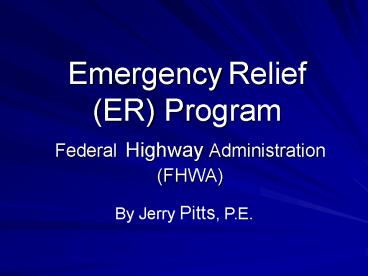Federal Highway Administration FHWA - PowerPoint PPT Presentation
1 / 16
Title:
Federal Highway Administration FHWA
Description:
Natural disasters include: floods, hurricanes, earthquakes, tornadoes, tidal ... repairs to damaged roadways caused by a natural disaster or catastrophic failure, ... – PowerPoint PPT presentation
Number of Views:66
Avg rating:3.0/5.0
Title: Federal Highway Administration FHWA
1
Federal Highway Administration (FHWA)
- Emergency Relief (ER) Program
By Jerry Pitts, P.E.
2
What is Federal-Aid Emergency Relief (ER)
Program?
- Emergency relief is a special program from
the Highway Trust Fund for the repair or
reconstruction of Federal-aid highways which have
suffered serious damage as a result of (1)
natural disasters or (2) catastrophic failures
from an external cause.
3
- Natural disasters include floods, hurricanes,
earthquakes, tornadoes, tidal waves, severe
storms, or landslides. - Catastrophic failure is defined as the sudden
and complete failure of a major element or
segment of the highway system that causes a
disastrous impact on transportation services. The
failure must be catastrophic in nature.
Additionally, in order to be eligible for ER, the
cause of the failure must be determined to be
external to the facility. Both conditions must be
satisfied. A bridge suddenly collapsing after
being struck by a barge is an example of a
catastrophic failure.
4
Eligibility for Emergency Relief funds
- The damage must be severe and wide spread
(Presidential Disaster Declaration). - Eligible cost of the damage must exceed 700,000
state wide per disaster event. - Damage at each site must exceed 5,000.
5
Emergency Relief Program has two major categories
- Emergency Repair
- Permanent Repair.
6
Emergency Repair
- Emergency repairs are those repairs during and
immediately following a disaster to restore
essential traffic, to minimize the extent of
damage, or to protect the remaining facilities. - These repairs can begin immediately following a
disaster, and prior FHWA approval is not
required. - Properly documented costs will later be
reimbursed once the FHWA Division Administrator
makes a finding that the disaster is eligible for
ER funding.
7
Emergency Repair
- Emergency repair work, accomplished in the first
180 days after the occurrence of the disaster,
may be reimbursed at 100 percent Federal share. - Emergency repairs accomplished more than 180 days
after the event may be reimbursed at 90 percent
for interstates and 80 percent for all other
highways.
8
Permanent Repairs
- Permanent repairs are those repairs undertaken
(usually after emergency repairs have been
completed) to restore the highway to its
predisaster condition. - Permanent repairs must have prior FHWA approval
and authorization unless done as part of the
emergency repairs. - Permanent repair work is reimbursed at normal pro
rata share unless permanent repair is performed
as an incidental part of emergency repair work. - Permanent repair reimbursement after an event
will be 90 percent for interstates and 80 percent
for all other highways.
9
What is Eligible under the ER Program?
- Generally, all elements of the highway
within its cross section (right-of-way) damaged
as a direct result of a disaster are eligible for
repair under the ER program. This includes, but
is not limited to, elements such as pavement,
shoulders, slopes and embankments, guard rail,
signs and traffic control devices, bridges,
culverts, bank control features, bike and
pedestrian path, fencing, and retaining walls. - The intent of the ER program is to fund
repairs to damaged roadways caused by a natural
disaster or catastrophic failure, not repairs to
roadways damaged as a result of preexisting and
non-disaster related, i.e., inherent deficient
conditions.
10
What is Eligible under the ER Program?
- Engineering and Right-of-Way
- Detours
- Overlays
- Roadside Appurtenances
- Timber and Debris Removal
- Etc.
11
What is ineligible Under the ER Program?
- ER funds are not intended for all damage
repair costs. Only that repair work which exceeds
heavy maintenance, is extraordinary, and will
restore predisaster service is eligible. - Damage Estimate Under 5,000 per Site
- Applicant - Owned Material
- Prior Scheduled Work
- Emergency/Medical Transportation Services
- Mitigation/Preventive Work Prior to Disaster
- Catastrophic Failure from Internal Cause
12
What Classifies as a Federal-aid Route?
- A Federal-aid route is based on the State
Highway Functional Classification - Rural Any route above a Minor Collector.
- Urban Any route above a Local Road.
- Color coded maps delineate FHWA/ FEMA routes.
13
Federal-aid Routes
14
What determines a site?
- The Emergency Relief Manual leaves it to the
Division Offices to define a site. The Louisiana
Division Office defines a site as follows - Rural route within a parish.
- (ex. US 190, US 90, Hwy 1)
- Each bridge on a rural or urban route.
- Route in a large urban area (Baton Rouge, Lake
Charles, etc.). - A small urban area (urban routes).
15
Conclusion
- Federal-Aid ER is a reimbursement program, not a
GRANT. - Each entity must maintain good records and
invoices of work completed. - Permanent repair work must have prior FHWA
approval.
16
Questions???
Jerry Pitts, P.E. Federal Highway
Administration 225-757-7618
http//www.fhwa.dot.gov/reports/erm































